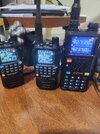TIDRADIO contacted me a few weeks go, asking if I would like to review their new micro-sized TD-H3 VHF/UHF handheld, which features USB-C and bluetooth interfaces. Of course, I can't resist playing with new radio toys, so the radio arrived a few days later.
First, this is a TINY radio! In this pic, you can see I'm holding it comfortably between my thumb and index finger. It is similar in size to the old Yaesu VX-3 but more narrow.

For comparison, Here's a pic of it next to the TIDRADIO TD-H8, which is full-sized radio by today's standards.
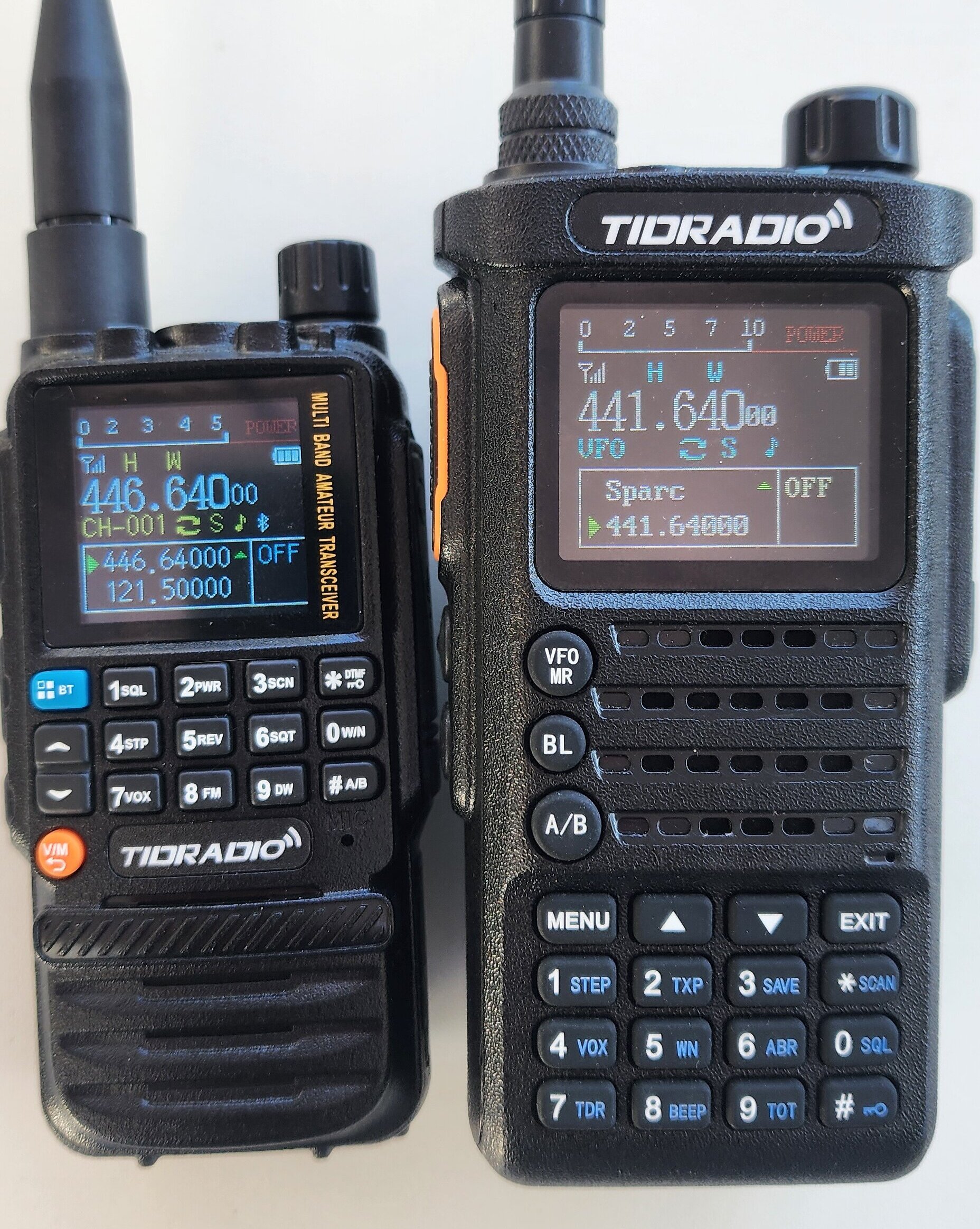
There are quite a few of reviews of this new TD-H3 published already, including on youtube. Later in this review, I'll discuss some of the best features, as well as some areas for improvement, but before I go any farther, I'm starting with this: I can't find much not to like about this radio, including the fact that according to my tests, it seems to comply with FCC specs for spurious emissions, which surprised me in a very positive way. So now that we have the size comparisons out of the way, let's look at the spectrum analyzer tests.
To test these radios, I use an AURSINC TinySA Ultra, fed through a a 40db attenuator, both available on Amazon:


As a refresher, the FCC rules for VHF transmitters with average power less than 25 watts must be at least 40db below the fundamental frequency and not more than 25 microwatts. For the first test, I set the radio operating frequency on 146.52, which is the signal shown in the far left of the graphic.

The test shows that the worst spurious emission is almost -51db. Since the TD-H3 is a 5 watt transmitter, the worst harmonic is only 31 microwatts. The db specs are well within the FCC specs but the power output of the worst spur is slightly over the spec. But still, this is about the best I've ever seen with an inexpensive radio.
The next image shows the same test on 440Mhz.

These results are well within the FCC specs. I have to admit that I was pleasantly surprised by this. Most of these sub $100 radios have a reputation for having filthy harmonics, but that is certainly not the case with the TD-H3. One last test: The radio has a menu option to enable transmission on 220Mhz. Users should be aware that the supplied antenna is labeled as a 144/435 Mhz unit on the underside; I tested that antenna on 220 Mhz and it should not be used on that band. If you intend to use the radio on 220, get an antenna designed for that band. Because the radio has the option to operate on 220, of course I ran a spec analyzer test there, as well.

On this band, the radio is not within FCC specs (although it's not horrible), but since TIDRADIO advertises this only as a 2M/440 radio, I'll cut them some slack. To put all of these tests in perspective, this is the first $30 VHF/UHF radio I've ever seen that complies with FCC spurious emissions specs, so this is a big deal.
Now let's cover a few other interesting features. Unlike some other radios of this size, the TD-H3 features a bluetooth interface for programming. Like their other radio, the TD-H8, bluetooth only works with their own Odmaster app, which is available for both Android and Apple smartphones. In my tests, it worked flawlessly and the Odmaster app continues to receive improvements in usability. I especially like that you can save your frequency lists with your account and use them with various radios. Note that a few of the TD-H3 menus, such as enabling TX on 220Mhz and 500Mhz are not available in the Odmaster app.
The TD-H3 also features a USB-C interface for both charging an programming. On this radio, the feature is both cool and a little odd at the same time because there are two USB-C ports used for different purposes. The USB-C on the bottom on the battery is for charging:
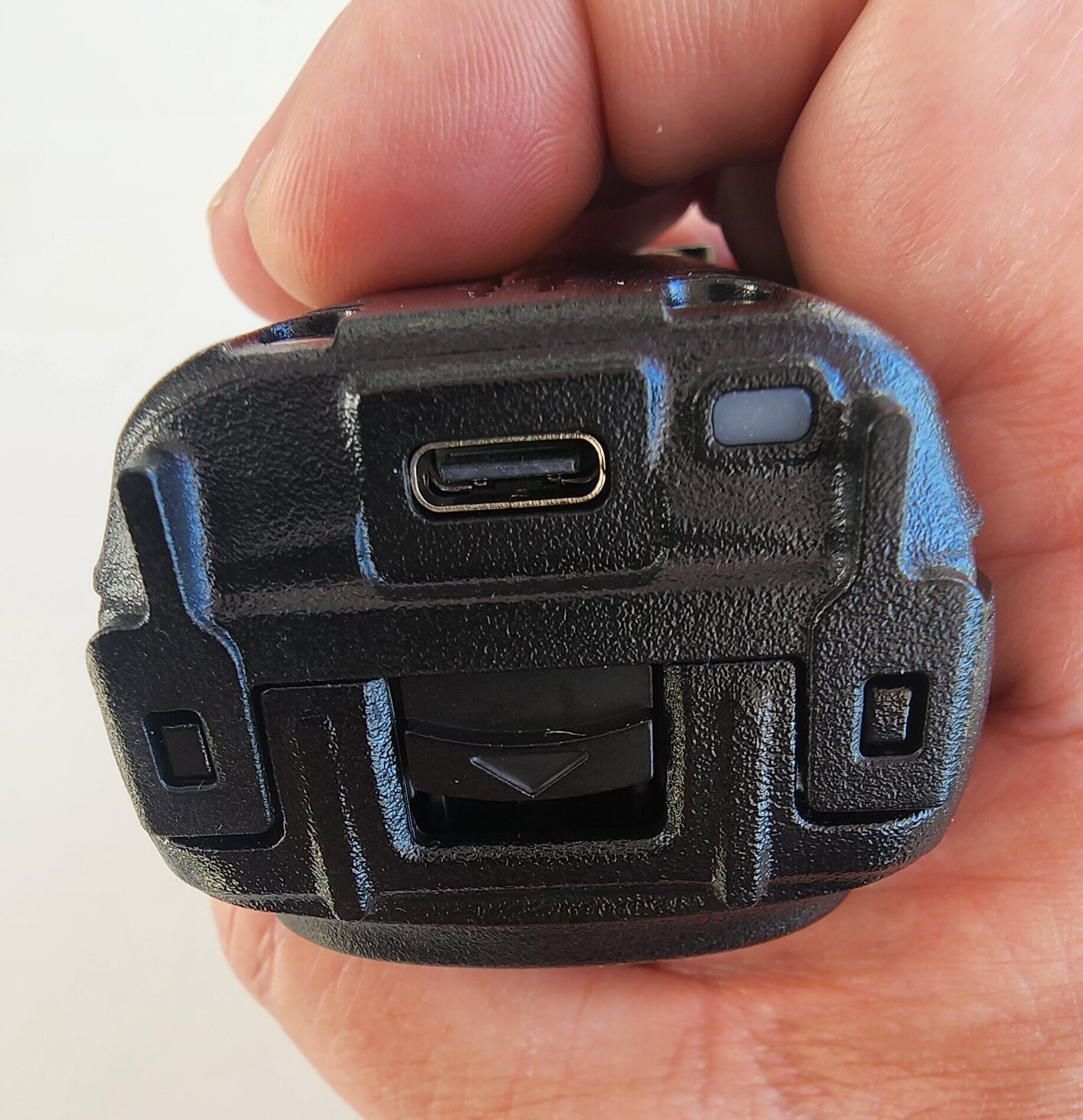
The USB-C port on the side of the radio is for programming, using either the Odmaster web app or Chirp.
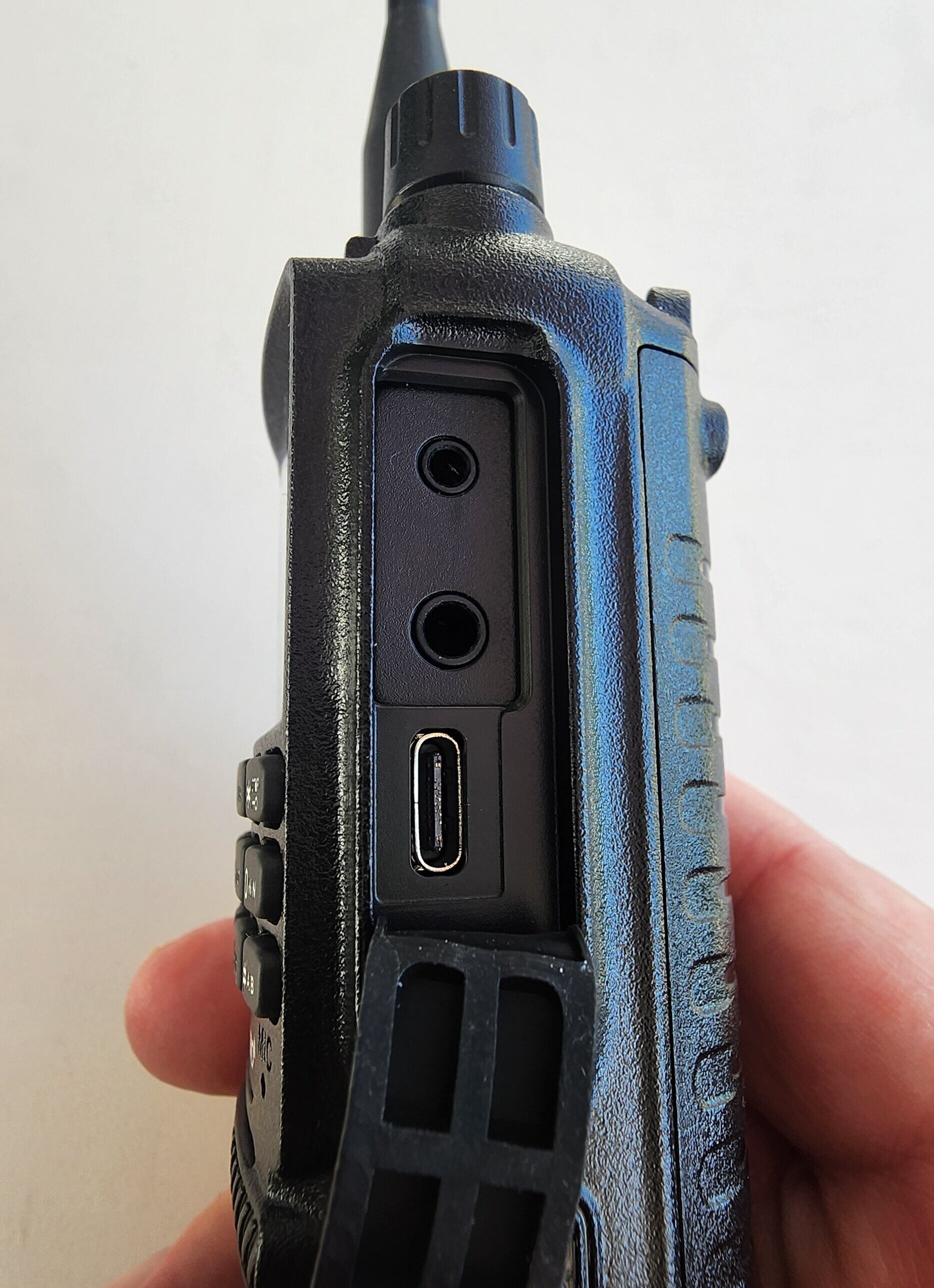
Unlike the Kenwood TH-D75, the USB-C port on the radio will not charge the battery. Also of note is that the USB-C on the battery will not charge if plugged into a PD port, which is unfortunate because that means it won't work on some car chargers unless they are also equipped with an extra USB-A port.
Another interesting design choice of this radio is the inclusion of two PTT buttons, shown here:
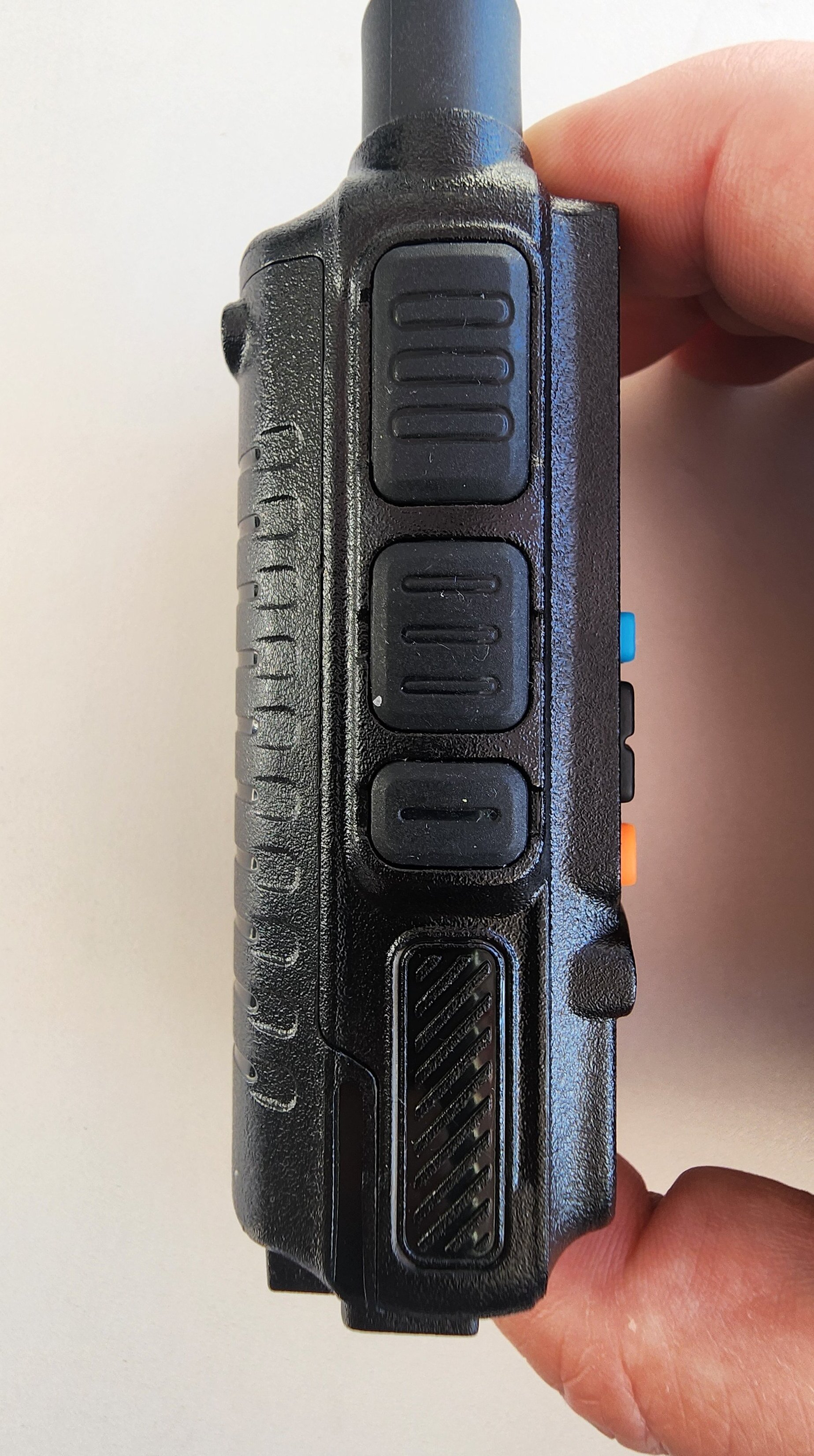
The top button activates VFO A and the bottom PTT button actives VFO B. I have to admit, this took me a while to get used to. As of the time of this writing there is also an annoying bug, which I've notified TIDRADIO about. When you have dual watch enabled, if VFO B is the active one due to activity, if you press the top PTT, the radio displays the TX details of VFO B instead of VFO A. The company indicates that they may fix this in a future firmware update. Regarding firmware updates, the USB-C cable is not used for performing this operation. Instead, you need a USB-A cable that interfaces with the standard Kenwood speaker/mic interface, which I find a bit odd.
I have one other very minor gripe about this radio. Like all radios at the sub $100 price point, the scanner function is horribly slow. But on the more important upside, this radio covers the AM air band! The radio also features FM broadcast and it has WX frequencies pre-programmed. The easiest way to access the pre-programmed WX frequencies is to reprogram the bottom soft-button to activate. I did this with the Odmaster app when using a long-press, overriding the default monitor function.
Like the TD-H8, the H3 also has the ability to clone itself via bluetooth. You do this by holding down the bottom side button while turning the radio on, resulting in the following menu:

Since I only have the one unit, I did not test this feature, but there are youtubers that show it functioning as advertised.
I have been using this radio daily for weeks. I really can't find much to complain about at this price point and a whole bunch to like. The volume is quite loud and the audio quality is very good. The radio fits in your average pants pocket and is easy to program with either Odmaster via bluetooth or Chirp using USB-C. It's so small, that it's a radio that I literally carry everywhere. TIDRADIO sells several antenna options that make it even more "pocket friendly". The radio is sold as GMRS or HAM, but you can also completely unlock it by holding down the top PTT and * key while turning it on. I feel no guilt in using this radio since it meets the FCC spurious emissions standards. Considering it also covers the air band, 220Mhz, weather, and FM broadcast, I don't see how you can go wrong at this price point. The radio is available on Amazon in various packs of batteries and antennas: https://amzn.to/4djGvfp
Note: edited to clarify the 2 meter spurious emissions test measurements.
First, this is a TINY radio! In this pic, you can see I'm holding it comfortably between my thumb and index finger. It is similar in size to the old Yaesu VX-3 but more narrow.

For comparison, Here's a pic of it next to the TIDRADIO TD-H8, which is full-sized radio by today's standards.

There are quite a few of reviews of this new TD-H3 published already, including on youtube. Later in this review, I'll discuss some of the best features, as well as some areas for improvement, but before I go any farther, I'm starting with this: I can't find much not to like about this radio, including the fact that according to my tests, it seems to comply with FCC specs for spurious emissions, which surprised me in a very positive way. So now that we have the size comparisons out of the way, let's look at the spectrum analyzer tests.
To test these radios, I use an AURSINC TinySA Ultra, fed through a a 40db attenuator, both available on Amazon:
As a refresher, the FCC rules for VHF transmitters with average power less than 25 watts must be at least 40db below the fundamental frequency and not more than 25 microwatts. For the first test, I set the radio operating frequency on 146.52, which is the signal shown in the far left of the graphic.

The test shows that the worst spurious emission is almost -51db. Since the TD-H3 is a 5 watt transmitter, the worst harmonic is only 31 microwatts. The db specs are well within the FCC specs but the power output of the worst spur is slightly over the spec. But still, this is about the best I've ever seen with an inexpensive radio.
The next image shows the same test on 440Mhz.

These results are well within the FCC specs. I have to admit that I was pleasantly surprised by this. Most of these sub $100 radios have a reputation for having filthy harmonics, but that is certainly not the case with the TD-H3. One last test: The radio has a menu option to enable transmission on 220Mhz. Users should be aware that the supplied antenna is labeled as a 144/435 Mhz unit on the underside; I tested that antenna on 220 Mhz and it should not be used on that band. If you intend to use the radio on 220, get an antenna designed for that band. Because the radio has the option to operate on 220, of course I ran a spec analyzer test there, as well.

On this band, the radio is not within FCC specs (although it's not horrible), but since TIDRADIO advertises this only as a 2M/440 radio, I'll cut them some slack. To put all of these tests in perspective, this is the first $30 VHF/UHF radio I've ever seen that complies with FCC spurious emissions specs, so this is a big deal.
Now let's cover a few other interesting features. Unlike some other radios of this size, the TD-H3 features a bluetooth interface for programming. Like their other radio, the TD-H8, bluetooth only works with their own Odmaster app, which is available for both Android and Apple smartphones. In my tests, it worked flawlessly and the Odmaster app continues to receive improvements in usability. I especially like that you can save your frequency lists with your account and use them with various radios. Note that a few of the TD-H3 menus, such as enabling TX on 220Mhz and 500Mhz are not available in the Odmaster app.
The TD-H3 also features a USB-C interface for both charging an programming. On this radio, the feature is both cool and a little odd at the same time because there are two USB-C ports used for different purposes. The USB-C on the bottom on the battery is for charging:

The USB-C port on the side of the radio is for programming, using either the Odmaster web app or Chirp.

Unlike the Kenwood TH-D75, the USB-C port on the radio will not charge the battery. Also of note is that the USB-C on the battery will not charge if plugged into a PD port, which is unfortunate because that means it won't work on some car chargers unless they are also equipped with an extra USB-A port.
Another interesting design choice of this radio is the inclusion of two PTT buttons, shown here:

The top button activates VFO A and the bottom PTT button actives VFO B. I have to admit, this took me a while to get used to. As of the time of this writing there is also an annoying bug, which I've notified TIDRADIO about. When you have dual watch enabled, if VFO B is the active one due to activity, if you press the top PTT, the radio displays the TX details of VFO B instead of VFO A. The company indicates that they may fix this in a future firmware update. Regarding firmware updates, the USB-C cable is not used for performing this operation. Instead, you need a USB-A cable that interfaces with the standard Kenwood speaker/mic interface, which I find a bit odd.
I have one other very minor gripe about this radio. Like all radios at the sub $100 price point, the scanner function is horribly slow. But on the more important upside, this radio covers the AM air band! The radio also features FM broadcast and it has WX frequencies pre-programmed. The easiest way to access the pre-programmed WX frequencies is to reprogram the bottom soft-button to activate. I did this with the Odmaster app when using a long-press, overriding the default monitor function.
Like the TD-H8, the H3 also has the ability to clone itself via bluetooth. You do this by holding down the bottom side button while turning the radio on, resulting in the following menu:

Since I only have the one unit, I did not test this feature, but there are youtubers that show it functioning as advertised.
I have been using this radio daily for weeks. I really can't find much to complain about at this price point and a whole bunch to like. The volume is quite loud and the audio quality is very good. The radio fits in your average pants pocket and is easy to program with either Odmaster via bluetooth or Chirp using USB-C. It's so small, that it's a radio that I literally carry everywhere. TIDRADIO sells several antenna options that make it even more "pocket friendly". The radio is sold as GMRS or HAM, but you can also completely unlock it by holding down the top PTT and * key while turning it on. I feel no guilt in using this radio since it meets the FCC spurious emissions standards. Considering it also covers the air band, 220Mhz, weather, and FM broadcast, I don't see how you can go wrong at this price point. The radio is available on Amazon in various packs of batteries and antennas: https://amzn.to/4djGvfp
Note: edited to clarify the 2 meter spurious emissions test measurements.
Last edited:

